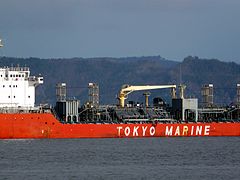Chemical tanker




A chemical tanker is a type of tanker ship designed to transport chemicals in bulk. As defined in MARPOL Annex II, chemical tanker means a ship constructed or adapted for carrying in bulk any liquid product listed in chapter 17 of the International Bulk Chemical Code.[1] As well as industrial chemicals and clean petroleum products, such ships also often carry other types of sensitive cargo which require a high standard of tank cleaning, such as palm oil, vegetable oils, tallow, caustic soda, and methanol.
Oceangoing chemical tankers range from 5,000 tonnes deadweight (DWT) to 35,000 DWT in size, which is smaller than the average size of other tanker types due to the specialized nature of their cargo and the size restrictions of the port terminals where they call to load and discharge.
Chemical tankers normally have a series of separate cargo tanks which are either coated with specialized coatings such as phenolic epoxy or zinc paint, or made from stainless steel. The coating or cargo tank material determines what types of cargo a particular tank can carry: stainless steel tanks are required for aggressive acid cargoes such as sulfuric and phosphoric acid, while 'easier' cargoes — such as vegetable oil — can be carried in epoxy coated tanks. The coating or tank material also influences how quickly tanks can be cleaned. Typically, ships with stainless steel tanks can carry a wider range of cargoes and can clean more quickly between one cargo and another, which justifies the additional cost of their construction.
Classification
In general, ships carrying chemicals in bulk are classed into three types:
Type 1
Type 1 ship is a chemical tanker intended to transport Chapter 17 of the IBC Code products with very severe environmental and safety hazards which require maximum preventive measures to preclude an escape of such cargo.
Type 2
Type 2 ship is a chemical tanker intended to transport Chapter 17 of the IBC Code products with appreciably severe environmental and safety hazards which require significant preventive measures to preclude an escape of such cargo.
Type 3
Type 3 ship is a chemical tanker intended to transport Chapter 17 of the IBC Code products with sufficiently severe environmental and safety hazards which require a moderate degree of containment to increase survival capability in a damaged condition.[2] Most chemical tankers are IMO 2 and 3 rated, since the volume of IMO 1 cargoes is very limited.
Main Characteristics of Chemical Tankers
Chemical tankers often have a system for tank heating in order to maintain the viscosity of certain cargoes, typically by passing pressurized steam through stainless steel 'heating coils' in the cargo tanks, transferring heat into the cargo which circulates in the tank by convection. All modern chemical tankers feature double hull construction and most have one pump for each tank with independent piping, which means that each tank can load a separate cargo without any mixing. Tank cleaning after discharging cargo is a very important aspect of chemical tanker operations, because tanks which are not properly cleaned of all cargo residue can adversely affect the purity of the next cargo loaded. Before tanks are cleaned, they must be properly ventilated and checked to be free of potentially explosive gases. Chemical tankers usually have transverse stiffeners on deck rather than inside the cargo tanks, in order to make the tank walls smooth and easier to clean by fitted tank cleaning machines.
Cargo tanks, either empty or filled, are normally protected against explosion by inert gas blankets. Often nitrogen is the inert gas used, supplied either from portable gas bottles or a Nitrogen generator.
Most new chemical tankers are built by shipbuilders in Japan, Korea or China, with other builders in Turkey, Italy, Germany and Poland. Japanese shipbuilders now account for the large majority of stainless steel chemical tankers built, as welding stainless steel to the accuracy required for cargo tank construction is a skill which is difficult to acquire.
Notable major chemical tanker operators including Stolt-Nielsen, Odfjell, Tokyo Marine and Eitzen Chemical. Charterers, the end users of the ships, include oil majors, industrial consumers and specialist chemical companies.
